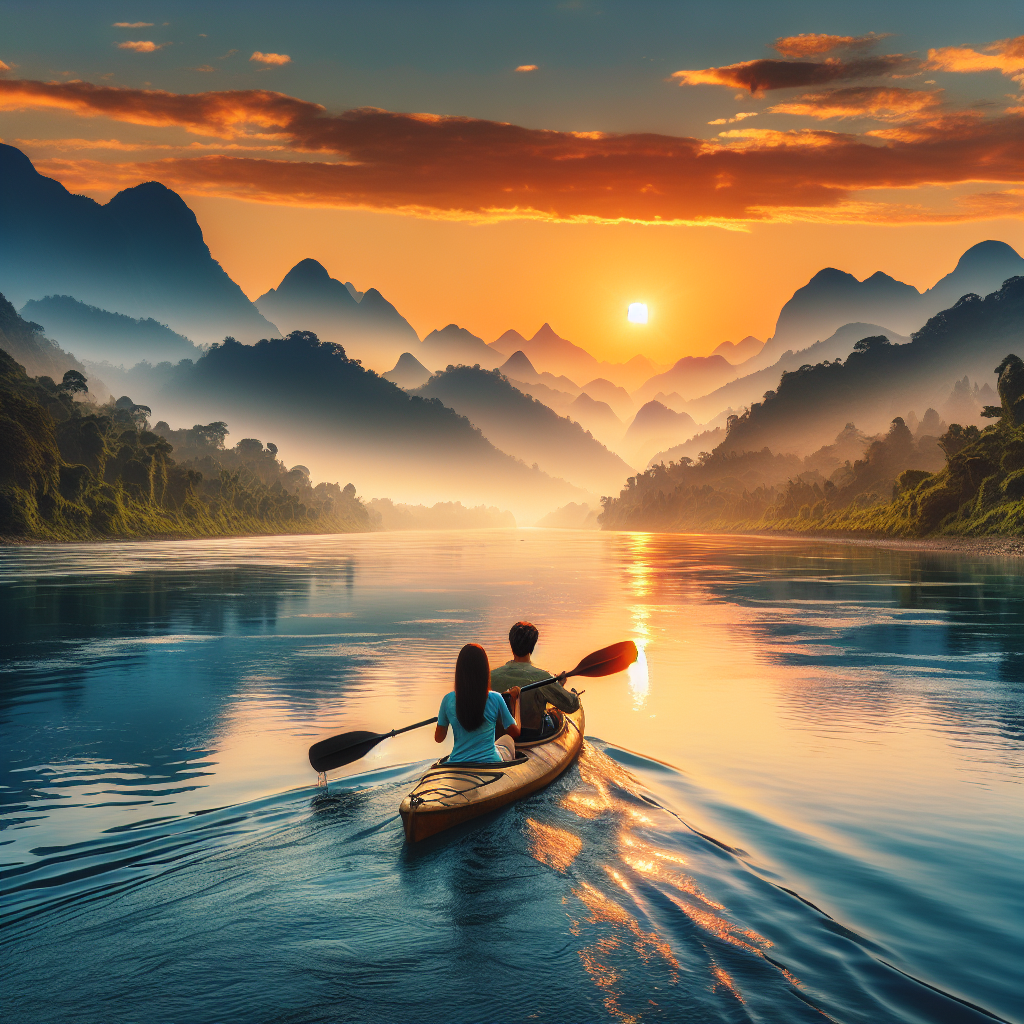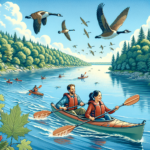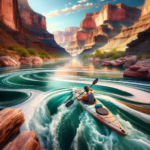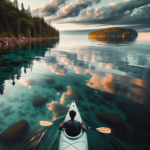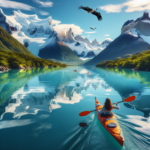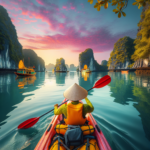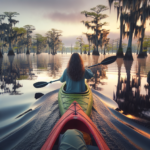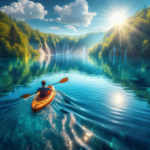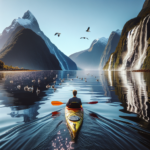Kayaking in Brahmaputra River, India/Tibet
Introduction to Kayaking
Kayaking is an exhilarating outdoor activity that has gained immense popularity worldwide. It offers a unique blend of adventure, exercise, and a close connection with nature. Whether you’re navigating through calm lakes, challenging river rapids, or exploring coastal waters, kayaking provides a thrilling experience that appeals to both beginners and seasoned paddlers. The sport’s versatility and the sense of freedom it offers make it a favorite among outdoor enthusiasts.
In this article, we will spotlight the unique features of kayaking in the Brahmaputra River, which flows through India and Tibet. This majestic river offers a fantastic destination for kayaking enthusiasts, combining breathtaking scenery, challenging rapids, and a rich cultural backdrop. Our goal is to provide a comprehensive guide to kayaking in this region, covering everything from the best spots to safety regulations and environmental considerations.
Kayaking in the Brahmaputra River is a unique experience due to its diverse landscapes, ranging from serene stretches to turbulent rapids. The river’s vast expanse and the surrounding natural beauty make it a prime location for adventure seekers. Additionally, the cultural significance of the Brahmaputra River adds a layer of depth to the kayaking experience, making it not just an adventure but also a journey through history and tradition.
Overview of Kayaking in Brahmaputra River, India/Tibet
The Brahmaputra River, known as the Yarlung Tsangpo in Tibet, is one of the major rivers in Asia, flowing through Tibet, India, and Bangladesh. Its journey begins in the Tibetan Himalayas, where it carves through deep gorges and high-altitude landscapes before descending into the plains of India. The river’s geography is incredibly diverse, offering a range of kayaking experiences from tranquil waters to challenging rapids.
The climate along the Brahmaputra River varies significantly depending on the region and altitude. In Tibet, the river flows through a high-altitude, cold desert climate, while in India, it traverses tropical and subtropical zones. The best time to visit for kayaking is during the post-monsoon season, from October to April, when the water levels are stable, and the weather is relatively mild.
Historically, the Brahmaputra River has been a vital waterway for trade and transportation. While kayaking as a sport is relatively new to the region, the river has always been central to the lives of the local communities. Today, it is increasingly recognized as a premier destination for adventure sports, attracting kayakers from around the world.
Accessing the Brahmaputra River for kayaking is relatively straightforward. The most popular entry points are in the Indian states of Arunachal Pradesh and Assam. These regions are well-connected by road and air, making it easy for visitors to reach the river. Local tour operators offer guided kayaking trips, ensuring that even those unfamiliar with the area can enjoy a safe and memorable experience.
Kayaking Conditions in Brahmaputra River, India/Tibet
The Brahmaputra River offers a variety of water conditions suitable for different levels of kayaking expertise. In Tibet, the river is characterized by its high-altitude, fast-flowing waters, making it ideal for experienced kayakers seeking a challenge. As the river descends into India, it widens and slows down, offering more accessible conditions for beginners and intermediate paddlers.
The weather conditions along the Brahmaputra River can vary widely. In Tibet, the climate is cold and dry, with temperatures often dropping below freezing. In contrast, the Indian sections of the river experience a tropical climate, with hot summers and mild winters. The monsoon season, from June to September, brings heavy rainfall and high water levels, making kayaking dangerous during this period.
Tides and water currents are significant factors to consider when kayaking in the Brahmaputra River. The river’s flow is influenced by snowmelt from the Himalayas and seasonal rainfall, leading to fluctuating water levels. Kayakers should be aware of these changes and plan their trips accordingly. Local guides can provide valuable insights into the best times and conditions for kayaking.
Environmental factors such as water temperature, wind conditions, and potential hazards like submerged rocks and strong currents should also be taken into account. Wearing appropriate gear, including wetsuits and life jackets, is essential for safety. Additionally, kayakers should be prepared for sudden weather changes, especially in the high-altitude regions of Tibet.
Top Spots for Kayaking in Brahmaputra River, India/Tibet
One of the top spots for kayaking on the Brahmaputra River is the stretch between Tuting and Pasighat in Arunachal Pradesh, India. This section is renowned for its challenging rapids, stunning scenery, and remote wilderness. The rapids here range from Class III to Class V, making it suitable for experienced kayakers looking for an adrenaline rush. The best time to kayak in this area is from November to March when the water levels are optimal.
Another popular spot is the section of the river flowing through Assam, particularly around the town of Guwahati. This part of the river is wider and calmer, offering a more relaxed kayaking experience. It’s an excellent choice for beginners and those looking to enjoy the scenic beauty of the region. The best time to visit is during the winter months, from October to February, when the weather is pleasant and the water levels are stable.
In Tibet, the Yarlung Tsangpo Grand Canyon is a must-visit for adventurous kayakers. Known as the world’s deepest canyon, it offers some of the most challenging and exhilarating kayaking experiences. The rapids here are extremely difficult, ranging from Class IV to Class VI, and should only be attempted by highly skilled kayakers. The best time to kayak in this region is from May to October, when the weather is relatively mild.
For those interested in a more cultural experience, the stretch of the river near Majuli Island in Assam is a great choice. Majuli is the world’s largest river island and is known for its vibrant culture and traditional Assamese lifestyle. Kayaking around the island offers a unique opportunity to explore its rich heritage and natural beauty. The best time to visit is from November to March.
Safety and Regulations
Safety is paramount when kayaking in the Brahmaputra River, given its diverse and often challenging conditions. Local regulations require all kayakers to wear life jackets and helmets at all times. It’s also recommended to carry a first-aid kit, a whistle, and a waterproof map of the area. For those unfamiliar with the river, hiring a local guide is highly advisable, as they can provide valuable insights into the safest routes and potential hazards.
In addition to personal safety gear, it’s essential to use a sturdy and reliable kayak suitable for the river’s conditions. For the more challenging rapids, a whitewater kayak is recommended, while a touring kayak is suitable for the calmer sections. Always check your equipment for any damage before setting out and ensure that you have a paddle leash to prevent losing your paddle in strong currents.
Emergency situations can arise unexpectedly, so it’s crucial to be prepared. Familiarize yourself with basic rescue techniques and know how to perform a wet exit and re-entry. In case of an emergency, stay calm and signal for help using your whistle or by waving your paddle. It’s also a good idea to inform someone onshore about your kayaking plans and expected return time.
Local authorities and tour operators often provide safety briefings and guidelines before embarking on a kayaking trip. Pay close attention to these briefings and follow all instructions carefully. Respecting local regulations and guidelines not only ensures your safety but also helps preserve the natural environment and cultural heritage of the Brahmaputra River.
Amenities and Accommodations
The regions along the Brahmaputra River offer a range of amenities to cater to kayaking enthusiasts. In popular kayaking spots like Tuting and Pasighat, you can find rental facilities that provide kayaks, paddles, and safety gear. Local guides and tour operators offer guided kayaking trips, ensuring a safe and enjoyable experience for visitors. These guided tours often include transportation, meals, and camping arrangements.
Accommodation options vary from basic camping sites to more comfortable hotels and lodges. In remote areas like Tuting, camping is the most common option, allowing you to immerse yourself in the natural beauty of the region. Campsites are usually set up along the riverbanks, providing easy access to the water. In more developed areas like Guwahati, you can find a range of hotels and guesthouses to suit different budgets.
For those looking to combine kayaking with other recreational activities, the Brahmaputra River region has plenty to offer. In addition to kayaking, you can enjoy activities like trekking, bird watching, and cultural tours. The region is home to diverse wildlife and lush landscapes, making it a paradise for nature lovers. Local tour operators often offer multi-activity packages, allowing you to make the most of your visit.
When planning your trip, it’s a good idea to book your accommodations and guided tours in advance, especially during the peak season. This ensures that you have everything arranged and can focus on enjoying your kayaking adventure. Whether you prefer the simplicity of camping or the comfort of a hotel, the Brahmaputra River region has something to offer for every type of traveler.
Environmental Considerations
Preserving the natural habitats and wildlife along the Brahmaputra River is of utmost importance. As a kayaker, you play a crucial role in minimizing your impact on the environment. Follow eco-friendly kayaking practices such as avoiding littering, using biodegradable products, and respecting wildlife. Always carry a trash bag with you and dispose of waste properly.
One of the key principles of eco-friendly kayaking is to leave no trace. This means leaving natural areas as you found them, without disturbing plants, animals, or natural features. Stick to designated camping sites and trails to minimize your impact on the environment. Avoid making loud noises that can disturb wildlife and keep a safe distance from animals.
Local conservation efforts and projects are in place to protect the Brahmaputra River’s unique ecosystem. Supporting these initiatives can make a significant difference. Consider participating in local conservation programs or donating to organizations working to preserve the river’s natural beauty. By doing so, you contribute to the long-term sustainability of this incredible kayaking destination.
Educating yourself about the local environment and its challenges is also essential. Understanding the importance of preserving the Brahmaputra River’s biodiversity and cultural heritage can enhance your appreciation of the area and inspire you to take responsible actions. Share your knowledge with fellow kayakers and encourage them to adopt eco-friendly practices as well.
Highlights
When comparing kayaking in the Brahmaputra River with other popular kayaking destinations, several unique features stand out. The river’s diverse landscapes, ranging from high-altitude gorges in Tibet to wide plains in India, offer a variety of kayaking experiences that few other locations can match. The challenging rapids in Arunachal Pradesh and the serene waters around Majuli Island provide options for kayakers of all skill levels.
The Brahmaputra River is also home to a rich array of biodiversity. The region supports numerous species of birds, fish, and mammals, making it a paradise for wildlife enthusiasts. The river’s unique geographical features, such as the Yarlung Tsangpo Grand Canyon, add to its allure, offering some of the most dramatic and breathtaking scenery in the world.
In terms of historical significance, the Brahmaputra River has been a vital lifeline for the communities along its banks for centuries. Its cultural importance is reflected in the traditions and lifestyles of the local people. Kayaking in this region offers a unique opportunity to connect with this rich heritage and gain a deeper understanding of the area’s history and culture.
Data-driven analysis shows that the Brahmaputra River is increasingly recognized as a premier destination for adventure sports. The combination of challenging rapids, stunning scenery, and cultural richness makes it a standout choice for kayaking enthusiasts. Whether you’re seeking an adrenaline-pumping adventure or a peaceful escape into nature, the Brahmaputra River has something to offer.
FAQ Section
- What is the best season to go kayaking in the Brahmaputra River? The best season is from October to April, post-monsoon, when water levels are stable and weather conditions are favorable.
- Are there beginner-friendly spots for kayaking? Yes, the section around Guwahati in Assam offers calmer waters suitable for beginners.
- What should I bring for a kayaking trip? Essential items include a life jacket, helmet, first-aid kit, waterproof map, whistle, and appropriate clothing for the weather conditions.
- Are kayak rentals available? Yes, rental facilities are available in popular kayaking spots like Tuting and Pasighat.
- How can I participate in local conservation efforts? You can support local conservation programs by donating or participating in initiatives organized by local organizations.
- Are guided kayaking tours available? Yes, local tour operators offer guided tours that include equipment, safety briefings, and sometimes meals and accommodation.
- What safety measures are in place? Local regulations require wearing life jackets and helmets. It’s also recommended to hire a local guide and carry emergency equipment.
Final Thoughts
Kayaking in the Brahmaputra River is a premier destination for adventure enthusiasts, offering a unique blend of challenging rapids, serene waters, and breathtaking scenery. The river’s diverse landscapes and rich cultural heritage make it a standout choice for kayakers of all skill levels. Whether you’re seeking an adrenaline-pumping adventure or a peaceful escape into nature, the Brahmaputra River has something to offer.
As you embark on your kayaking journey, it’s essential to respect local guidelines and conservation efforts. By adopting eco-friendly practices and supporting local initiatives, you contribute to the preservation of this incredible natural wonder. Your actions can help ensure that future generations can also enjoy the beauty and thrill of kayaking in the Brahmaputra River.
In conclusion, the Brahmaputra River offers an unparalleled kayaking experience that combines adventure, natural beauty, and cultural richness. Whether you’re a seasoned kayaker or a beginner, this destination promises an unforgettable journey. So pack your gear, respect the environment, and get ready to explore the majestic Brahmaputra River.

